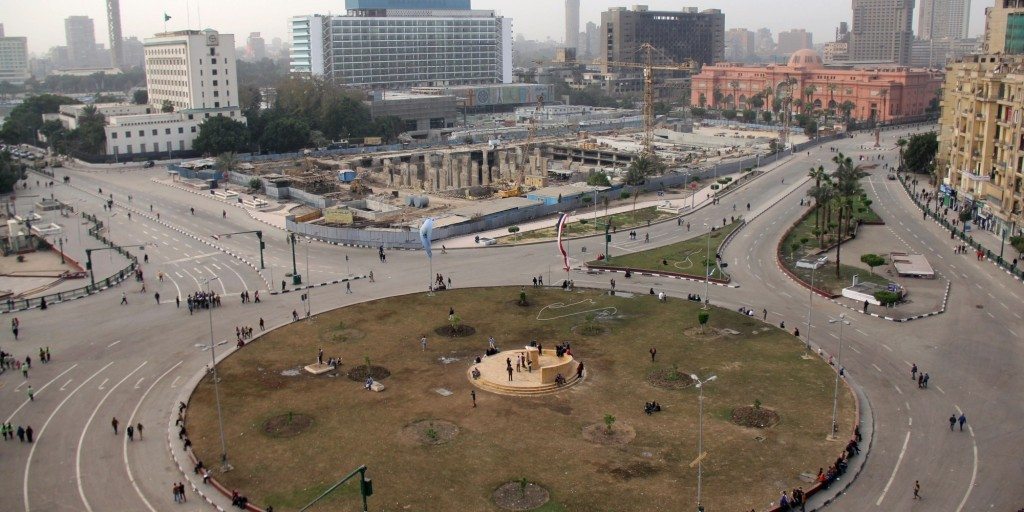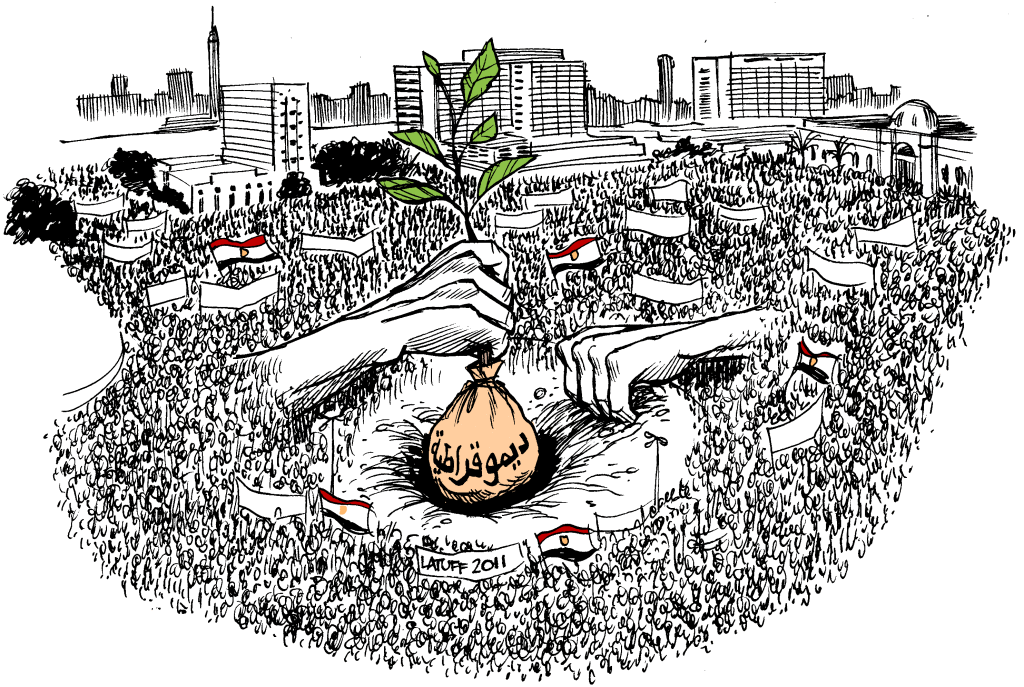Tahrir Square, also known as “Martyr Square”, is a major public town square in Downtown Cairo, Egypt. Tahrir square as we know it today would be barely recognizable from its past. After a trip to Paris, the Khedive Ismail Pasha sought to replicate Parisian architecture in downtown Cairo with Tahrir Square or Ismailia Square as it was known then at the centre of other European cities. This was one of the first known occurrences of the control of the square; its shift from a space to a place, the shift from farmland and gardens to a designated symbol of power in order to promote and exemplify Ismail’s power.
The Square has been the traditional site for numerous major protests and demonstrations in Egypt over the years, including the 1977 Egyptian Bread Riots, and the March 2003 protest against the War in Iraq. After the Egyptian Revolution of 1919, the square became widely known as Tahrir (Liberation) Square, but the Square was not officially renamed until the Egyptian Revolution of 1952, which changed Egypt from a constitutional monarchy into an autocratic republic. In Contemporary terms, it is presented as being the nucleus of the popular uprising that ousted Hosni Mubarak in early 2011 and President Morsi in 2013.
The Tahrir Square is big and at its centre is a large and busy traffic circle. On the north-east side is a plaza with a statue of nationalist hero Omar Makram, celebrated for his resistance against Napoleon I’s invasion of Egypt, and beyond is the Omar Makram Mosque. The Square is the northern terminus of the historic Qasr al-Ayni Street, the western terminus of Talaat Harb Street, and via Qasr al-Nil Street crossing its southern portion, it has direct access to the Qasr al-Nil Bridge crossing the nearby Nile River.
Tahrir Square is part of the daily life for many people; it’s a major downtown square surrounded by important government headquarters and major cultural institutions, and it’s a busy crossroad jammed with honking cars and buses. For tourists, Tahrir is the locale of the famed Egyptian Museum; for some Cairenes, it is the destination for official state business, while for many others it is one of the over-congested places of downtown Cairo to be avoided.
Read Also: 10 Things Every African Should Know ABout Cleopatra
The area around Tahrir Square includes the Egyptian Museum, the House of Folklore, the National Democratic Party-NDP headquarters building, the Mogamma government building, the Headquarters of the Arab League building, the Nile Hotel, Kasr El Dobara Evangelical Church and the original downtown campus of the American University in Cairo.
The Cairo Metro serves Tahrir Square with the Sadat Station, which is the downtown junction of the system’s two lines, linking to Giza, Maadi, Helwan, and other districts and suburbs of Greater Cairo. Its underground access viaducts provide the safest routes for pedestrians crossing the broad roads of the heavily trafficked square.
The modernization of the Square and Egypt as a whole by Ismail’s regime, placed Egypt in serious debt and in the words of Haris Naeem, Ironically, in the modernizing or Europeanizing downtown Cairo and the square, Ismail Pasha suffered economically and was consequently overthrown by British forces…’ After British and French forces left, King Farouk, the grandson of Ismail came to power, and like his grandfather, he sought to control Tahrir for political purposes, issuing a statue of himself to be placed on a pedestal in the square but was overthrown himself in 1952.
The mass protests which took place from 25th January until Hosni Mubarak’s resignation on 11th February occurred in Tahrir square with thousands of protesters displaying their disdain against the Mubarak government with the Square as the epicentre of all the protests. After the ousting of Mubarak, the power to control what happens in the square shifted into the hands of the people rather than the government so that they controlled who goes there and what happens there.
When the Tamrod movement sprung up against the increasing authoritarianism of the very first democratic government of Egypt, and asked that another election be held, although they had the support of the people and that of the police, the people banned the police and the army from entering the square until after the army had overthrown the government.
Even with the mighty significance attached to the square, and while the Square is attributed to good rather than bad, the number of rape activities that took place during the demonstrations in 2011 skyrocketed in 2013. Because the police were banned from entering the Square, mass rape went on the rise. According to Human Rights Watch, “mobs sexually assaulted and in some cases raped at least 91 women in Tahrir Square, over four days of protests beginning on June 30, 2013…. the rapes occurred in hot places like the entrance to the Mohammed Mahmoud from the Square, and to Sharia Tahrir” (HRW 2013). The location of the Square in the middle of downtown helps the rapists to abduct women easily and to escape after the crime.
Overall, Tahrir Square is more than a square to Egyptians. Without Tahrir, they would not have had their democracy, because of the advantageous geographical topography; it is an amalgamation of ideas, people and the symbolic power of the people, frequently contradictory but like the dreams of its inhabitants, eternally alive. Tahrir meaning liberation has liberated the people of Egypt.
Most importantly, the Tahrir Square is regarded as the hand that planted democracy in Egypt.




